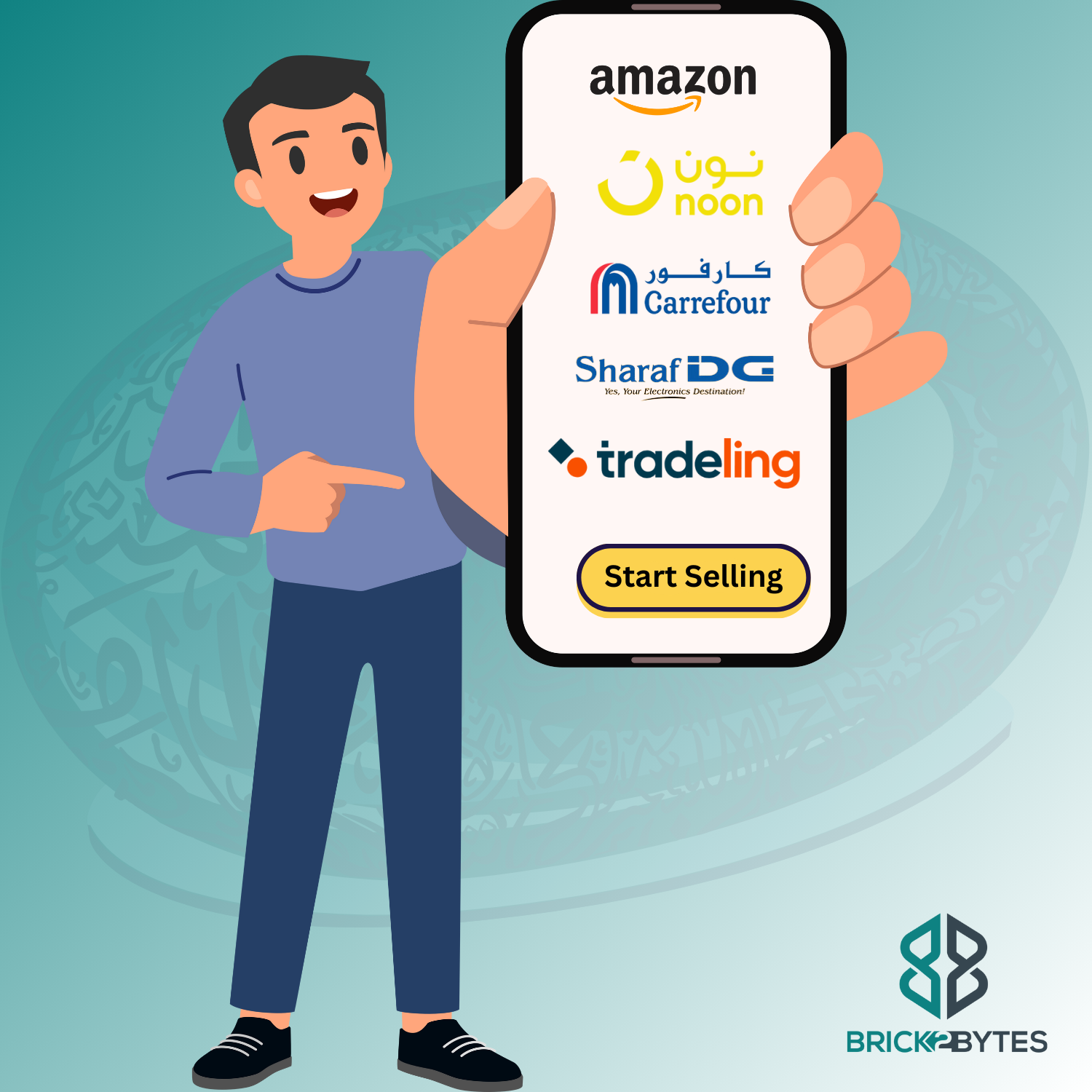The Power of Multi-Channel E-commerce
In today’s rapidly evolving e-commerce landscape, relying solely on a single online platform is like fishing with a single rod in a vast ocean teeming with diverse fish. Multi-channel e-commerce, the practice of selling your products on multiple online platforms, is the key to casting a wider net and reeling in a greater catch of customers and sales.
Imagine your online store as a bustling marketplace, but instead of being confined to a single location, you have the opportunity to set up shop in multiple thriving markets simultaneously. This is the essence of multi-channel e-commerce – expanding your reach and diversifying your revenue streams by selling your products across various online channels like Amazon, Noon, Namshi, Tradeling Marketplace, and your own online store.
The benefits of this approach are manifold. By diversifying your sales channels, you not only increase your brand visibility and reach a wider audience but also reduce your dependence on any single platform. This mitigates the risk of losing sales if one platform experiences a decline in traffic or changes its policies.
Moreover, multi-channel e-commerce allows you to cater to different customer preferences and shopping habits. Some customers prefer the convenience of Amazon, while others enjoy the unique offerings on Noon. By being present on multiple platforms, you can meet your customers where they are and provide them with a seamless shopping experience.
According to a study by Statista, businesses selling on 3 or more channels saw a 190% increase in revenue compared to those selling on only one channel. This statistic underscores the immense potential of multi-channel e-commerce for businesses of all sizes.
However, venturing into multi-channel e-commerce requires a well-thought-out strategy. It’s not just about listing your products on multiple platforms; it’s about creating a cohesive brand experience, managing inventory and orders efficiently, and tailoring your marketing efforts for each channel.
In this comprehensive guide, we will delve into the world of multi-channel e-commerce, exploring the benefits, challenges, and best practices for success. We’ll provide you with actionable insights and practical tips to help you expand your reach, boost your sales, and build a thriving online business. So, let’s dive in and discover how multi-channel e-commerce can transform your business and unlock new growth opportunities.
1. Choosing the Right Channels for Your Business in the UAE
The UAE e-commerce landscape is a vibrant and rapidly growing market, offering a plethora of opportunities for businesses to expand their reach and boost sales. However, with so many options available, selecting the right e-commerce channels for your business can be a daunting task.
In this section, we’ll guide you through the process of evaluating different platforms and identifying the ones that best align with your target audience, product type, and business goals.
Popular E-commerce Channels in the UAE
The UAE boasts a diverse range of e-commerce platforms, each catering to specific niches and customer preferences. Some of the most popular channels include:
- Noon: A homegrown e-commerce giant that dominates the market and offers a wide range of products, from electronics and fashion to groceries and home goods.
- Amazon.ae: The UAE version of the global e-commerce behemoth, offering a vast selection of products and reliable fulfillment services.
- Namshi: A popular fashion and lifestyle destination for trendy shoppers, known for its curated selection of clothing, shoes, and accessories.
- Dubizzle: A classifieds platform that has evolved into a major player in the e-commerce space, offering everything from used goods to new products.
- Mumzworld: A leading online marketplace for mother and baby products, catering to the needs of parents and expectant mothers.
In addition to these major players, there are also numerous niche marketplaces catering to specific interests and product categories.
Evaluating Channels Based on Your Target Audience
The first step in choosing the right e-commerce channels is to understand your target audience. Consider their demographics, interests, shopping habits, and preferred platforms. For example, if your target audience is primarily young, fashion-conscious shoppers, platforms like Namshi and Shein might be a good fit. On the other hand, if you’re selling baby products, Mumzworld and Firstcry would be a more relevant channel.
Evaluating Channels Based on Your Product Type
The type of products you sell will also influence your choice of channels. Some platforms specialize in certain product categories, while others offer a broader range. For instance, if you’re selling electronics, Noon and Amazon.ae might be ideal due to their strong presence in this category. If you’re selling handmade or vintage items, Etsy might be a better choice.
Evaluating Channels Based on Your Business Goals
Your business goals will also play a role in your channel selection. Are you looking to maximize sales volume, increase brand awareness, or reach a specific niche audience? Each channel has its own strengths and weaknesses, so it’s important to choose the ones that align with your overall business objectives.
Tips for Selecting the Right Mix of Channels
- Start with the most relevant channels: Begin by identifying the platforms that are most popular among your target audience and cater to your product type.
- Diversify your channels: Don’t put all your eggs in one basket. Selling on multiple channels can help you mitigate risk and reach a wider audience.
- Test and optimize: Experiment with different channels and track your performance. Focus on the channels that generate the most sales and engagement.
- Consider niche marketplaces: If you’re selling niche products, explore specialized marketplaces that cater to your specific target audience.
- Don’t forget your own online store: While marketplaces offer great exposure, having your own online store gives you more control over branding, customer experience, and pricing.
By carefully evaluating different e-commerce channels and choosing the right mix for your business, you can maximize your reach, boost your sales, and build a thriving multi-channel e-commerce empire in the UAE.
3. Creating a Cohesive Brand Experience Across Channels
Imagine walking into a luxury boutique and being greeted by a chaotic jumble of colors, mismatched furniture, and inconsistent signage. It would be a jarring experience that would likely leave you with a negative impression of the brand. The same principle applies to your online presence. In the world of multi-channel e-commerce, maintaining a consistent brand experience across all platforms is paramount to building trust, recognition, and loyalty among your customers.
The Importance of Consistency
Consistency in branding is the key to creating a strong and memorable identity for your business. When customers encounter your brand on different channels, they should instantly recognize it and associate it with the same values, quality, and personality. This builds trust and credibility, making them more likely to purchase from you, regardless of the platform they’re on.
Elements of a Cohesive Brand Experience
- Visual Identity: Your logo, color palette, typography, and overall visual style should be consistent across all channels. This creates a recognizable visual language that reinforces your brand identity.
- Messaging: Your brand voice, tone, and messaging should be aligned across all platforms. Whether it’s a product description on Amazon or a social media post on Instagram, your brand’s unique personality should shine through.
- Customer Experience: Strive to provide a seamless and consistent customer experience across all channels. This includes everything from browsing and purchasing to customer support and returns.
Tailoring Your Approach While Maintaining Consistency
While consistency is key, it’s also important to tailor your approach for each platform. Different channels have different audiences and formats, so you’ll need to adapt your product listings, marketing messages, and content accordingly. For example, a product description on Amazon might be more detailed and keyword-focused, while a social media post might be more casual and engaging.
4. Managing Inventory and Orders Across Multiple Channels: The Balancing Act of Multi-Channel E-commerce
As your e-commerce business expands across multiple channels, the complexity of managing inventory and orders increases exponentially. It’s like juggling multiple balls in the air, each representing a different platform with its own stock levels, order volumes, and fulfillment requirements. Without a well-structured system in place, you risk overselling, stockouts, delayed shipments, and ultimately, dissatisfied customers.
The Challenges of Multi-Channel Inventory Management
- Inconsistent Stock Levels: Keeping track of inventory across multiple platforms can be a logistical nightmare. A product might sell out on one channel while still being available on another, leading to confusion and missed sales opportunities.
- Overselling: Without real-time inventory updates, you might accidentally sell more products than you have in stock, resulting in canceled orders and disappointed customers.
- Manual Data Entry: Manually updating inventory and order information across different platforms is time-consuming, error-prone, and inefficient.
Streamlining Inventory Management with Software and Tools
Thankfully, there are numerous inventory management software and tools available to help you overcome these challenges. These solutions can:
- Centralize Inventory Data: Aggregate inventory data from all your sales channels into a single dashboard, providing a real-time view of your stock levels.
- Automate Inventory Updates: Automatically sync inventory levels across all platforms whenever a sale is made, preventing overselling and ensuring accurate stock information.
- Streamline Order Fulfillment: Integrate with your e-commerce platforms and shipping carriers to automate order processing, label printing, and tracking.
Popular inventory management software options for multi-channel e-commerce include:
- Sellbrite: A user-friendly platform that integrates with major marketplaces and shopping carts, offering features like listing management, inventory syncing, and order fulfillment.
- ChannelAdvisor: A comprehensive e-commerce solution that provides a wide range of features, including inventory management, order management, marketing automation, and analytics.
- Linnworks: A powerful inventory and order management platform designed for multi-channel sellers, offering features like order routing, inventory forecasting, and reporting.
5. Marketing and Advertising Your Multi-Channel Business: A Symphony of Strategies
In the bustling symphony of multi-channel e-commerce, marketing and advertising are your instruments, each playing a unique tune to attract and engage your audience across different platforms. A harmonious blend of these strategies is crucial for amplifying your brand’s voice, driving traffic to your listings, and ultimately, boosting sales.
The Importance of a Multi-Channel Marketing Strategy
A multi-channel marketing strategy involves coordinating your marketing efforts across various platforms to create a seamless and consistent brand experience for your customers. This means tailoring your message and content to each channel while maintaining a unified brand voice.
For instance, you might use Instagram to showcase visually appealing product images and engage with your audience through stories and reels. On LinkedIn, you might share thought leadership articles and industry insights to position your brand as an expert. Meanwhile, on your email list, you could send personalized product recommendations and exclusive discounts to nurture customer loyalty.
Leveraging Social Media, Email Marketing, and Paid Advertising
Social media platforms offer a powerful way to connect with your audience, build relationships, and drive traffic to your e-commerce stores. Create engaging content that resonates with your target audience, run contests and giveaways, and leverage influencer marketing to expand your reach.
Email marketing remains a highly effective tool for nurturing leads, driving repeat purchases, and building customer loyalty. Segment your email list based on customer preferences and purchase history, and send targeted campaigns with personalized offers and product recommendations.
Paid advertising, such as Google Ads and social media ads, can help you reach a wider audience and drive targeted traffic to your product listings. Consider using retargeting ads to re-engage with shoppers who have previously visited your website or viewed your products.
Optimizing Your Marketing Campaigns
To maximize the effectiveness of your multi-channel marketing efforts, it’s important to optimize your campaigns for each platform. This includes:
- Tailoring your message and content: Craft messages that resonate with the specific audience of each channel.
- Using relevant keywords: Research and incorporate keywords that your target customers are likely to use when searching for products on each platform.
- Tracking your results: Use analytics tools to measure the performance of your campaigns and identify areas for improvement.
6. Measuring and Analyzing Your Multi-Channel Performance: The Compass for Data-Driven Decisions
In the world of multi-channel e-commerce, data is your compass, guiding you towards informed decisions and optimal strategies. By meticulously tracking and analyzing your performance across various channels, you can uncover valuable insights, identify areas for improvement, and ultimately steer your business towards greater success.
The Importance of Tracking Key Performance Indicators (KPIs)
KPIs are quantifiable metrics that provide valuable insights into the health and performance of your multi-channel business. By tracking these metrics, you can:
- Measure your success: Assess your progress towards your business goals and identify areas where you’re excelling or falling short.
- Identify trends: Spot emerging patterns and opportunities in your sales data, customer behavior, and marketing performance.
- Make informed decisions: Use data-driven insights to optimize your product offerings, pricing strategies, marketing campaigns, and overall business operations.
Key KPIs to Track for Multi-Channel E-commerce
- Sales: Monitor your sales volume, revenue, and average order value across all channels.
- Traffic: Track the number of visitors to your product listings and website from each channel.
- Conversion Rate: Measure the percentage of visitors who make a purchase on each platform.
- Customer Acquisition Cost (CAC): Calculate the average cost of acquiring a new customer through each channel.
- Return on Investment (ROI): Evaluate the profitability of your marketing and advertising campaigns on each platform.
Conclusion
In the dynamic world of e-commerce, embracing a multi-channel strategy is no longer a luxury but a necessity for businesses aiming to thrive. By expanding your reach beyond a single platform, you unlock a wealth of opportunities to connect with diverse audiences, diversify your revenue streams, and mitigate risks associated with relying on a single marketplace.
Remember, successful multi-channel e-commerce requires a strategic approach. It’s about more than just listing your products on various platforms; it’s about crafting a cohesive brand experience, optimizing your operations, and tailoring your marketing efforts for each channel. By investing in the right tools, analyzing your performance data, and continuously adapting to the evolving e-commerce landscape, you can build a resilient and profitable online business that can weather any storm.
So, take the plunge into multi-channel e-commerce and unlock the full potential of your online business. Embrace the diversity of platforms, connect with new customers, and watch your sales soar as you navigate the exciting world of multi-channel selling.








